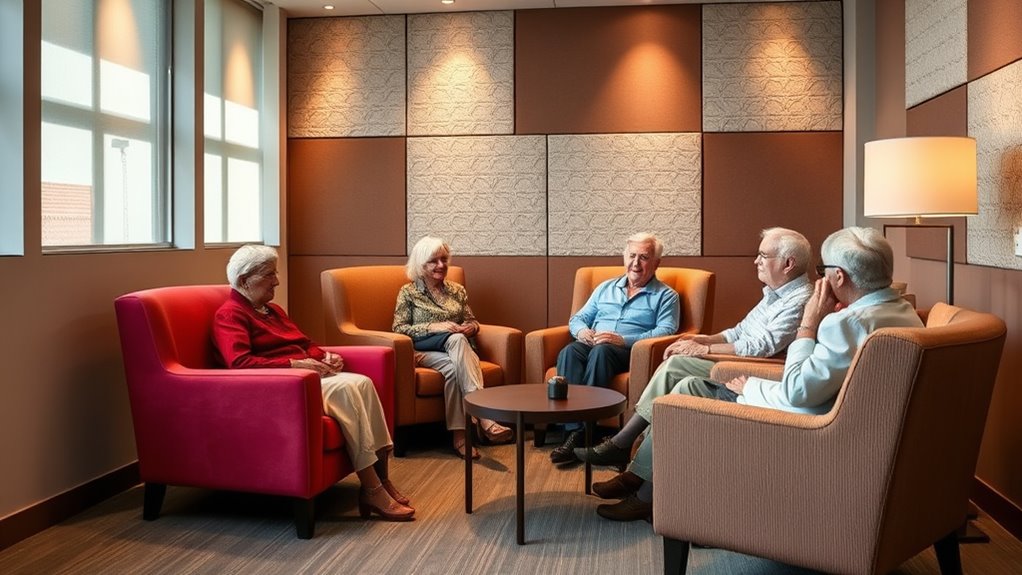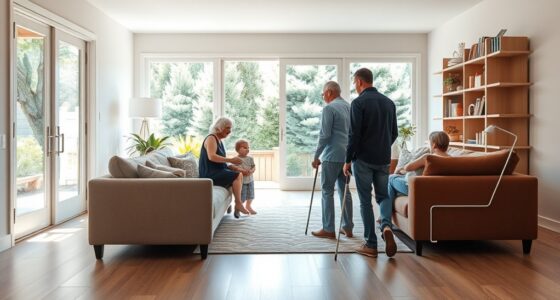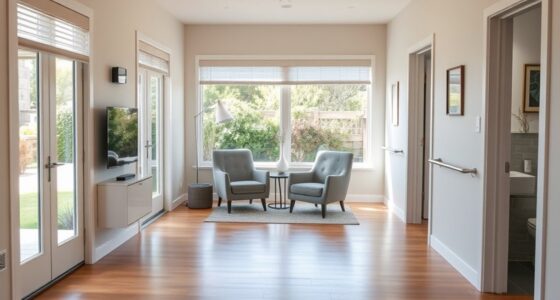To optimize lighting, sound, and texture for seniors, focus on creating a balanced environment that promotes safety, comfort, and engagement. Use adaptable lighting that follows circadian rhythms, combined with natural and soft illumination to reduce glare. Incorporate soothing sounds like nature or soft music to support relaxation, and add textured surfaces for tactile stimulation and safety. By combining these elements thoughtfully, you can craft spaces that enhance well-being—discover how to incorporate these principles effectively as you explore further.
Key Takeaways
- Use adaptive, circadian rhythm-aligned lighting to enhance visibility, safety, and sleep quality for seniors.
- Incorporate natural sounds or personalized audio to promote relaxation and reduce feelings of isolation.
- Select textured, tactile materials that are safe, non-slip, and easy to identify for sensory engagement and safety.
- Employ contrast and discreet lighting to improve visual clarity and highlight pathways or garden features.
- Integrate technology seamlessly with design elements to create intuitive, stimulating, and calming multisensory environments.

Have you ever wondered how design can improve the daily lives of seniors? It’s a question worth considering because thoughtful multisensory design can make a real difference. By carefully integrating lighting, sound, and textures, you create environments that are not only functional but also welcoming and stimulating. One key aspect is focusing on garden aesthetics, which can transform outdoor spaces into serene retreats that encourage relaxation and engagement. Incorporating natural elements like plants, water features, and varied textures can stimulate the senses and promote well-being. When you enhance garden aesthetics, you’re providing seniors with a connection to nature that’s both calming and invigorating. But it’s vital to think about technology integration as well. Modern tools, such as smart lighting systems, can adapt to natural circadian rhythms, guaranteeing well-lit spaces during the day and softer lighting at night, which helps regulate sleep patterns. Audio technology, like speakers that emit gentle nature sounds or personalized music, can elevate the sensory experience and reduce feelings of loneliness or agitation. Textures in furniture, flooring, and even outdoor surfaces should be chosen carefully—think non-slip materials, soft fabrics, and tactile garden elements that are easy to identify and navigate. These choices not only improve safety but also add layers of sensory richness, making the environment more engaging. Recognizing the importance of diverse environments, varied camping locations can serve as inspiration for creating multisensory spaces that cater to different preferences and needs. Incorporating elements from textile art techniques, such as textured fabrics or woven materials, can further enhance tactile engagement within the environment. When you combine these elements thoughtfully, you’re creating a multisensory environment that caters to seniors’ needs for clarity, comfort, and stimulation. For example, in a garden setting, you might use raised beds with textured surfaces for easy access and tactile pleasure, while integrating discreet lighting that highlights pathways and features. Technology can seamlessly support this setup, like motion-activated lights that illuminate when someone approaches or outdoor speakers that play calming sounds as they walk through. This integration ensures that the environment adapts to their needs, promoting independence and confidence. It’s about crafting spaces where every element works together to support sensory processing and emotional well-being. Paying attention to design elements and seamlessly incorporating technology can significantly enhance the sensory environment for seniors. A well-designed multisensory space considers sensory processing to ensure comfort and engagement for all users. Additionally, understanding how contrast ratio influences visual clarity can help in selecting appropriate lighting and visual cues, further supporting seniors’ safety and perception. When you pay attention to garden aesthetics and seamlessly incorporate technology, you’re not just designing a space—you’re enhancing daily experiences, encouraging activity, and fostering a sense of safety and comfort. Ultimately, multisensory design is a powerful way to improve quality of life for seniors, making their surroundings more intuitive, beautiful, and enriching. It’s a simple yet impactful approach that recognizes the importance of engaging all senses, helping seniors feel more connected, secure, and alive in their environment.
Frequently Asked Questions
How Does Multisensory Design Impact Seniors’ Mental Health?
You might wonder how multisensory design affects seniors’ mental health. It can boost emotional well-being by creating calming, engaging environments tailored to their needs. However, if not carefully balanced, sensory overload could cause stress or confusion. By thoughtfully optimizing lighting, sound, and textures, you help seniors feel more comfortable and supported, reducing anxiety and enhancing overall mental health. This approach makes daily life more positive and manageable for them.
Are There Specific Materials Best Suited for Senior-Friendly Textures?
Imagine walking into a space where every surface invites touch, like a gentle breeze guiding your hand. For seniors, senior-friendly fabrics and textured wall coverings are essential. Opt for soft, non-slip materials, and textured wall coverings with subtle patterns that provide tactile feedback without overwhelming. These materials enhance comfort, safety, and sensory engagement, making environments more accessible and pleasant, ultimately supporting their well-being and independence.
How Can Lighting Be Adjusted for Individuals With Visual Impairments?
To adjust lighting for individuals with visual impairments, you should focus on adaptive lighting that can be easily changed to meet their needs. Use glare reduction techniques to minimize discomfort and improve visibility. Incorporate adjustable fixtures, dimmers, and task lighting to enhance clarity and safety. By tailoring lighting levels and reducing glare, you create a more accessible environment that supports their independence and comfort.
What Are the Safety Considerations in Multisensory Environments?
When designing multisensory environments, you must prioritize safety by addressing trip hazard considerations and adhering to fire safety protocols. Guarantee pathways are clear and well-lit to prevent falls, and use non-slip surfaces. Regularly check for obstacles or loose fixtures. Additionally, install fire alarms and ensure exits are accessible. By doing so, you create a safe space that minimizes risks and promotes comfort for everyone, especially seniors.
How Does Multisensory Design Influence Cognitive Engagement in Seniors?
Imagine opening a treasure chest of memories—multisensory design does just that by boosting cognitive engagement in seniors. You facilitate sensory integration, which enhances cognitive stimulation, helping seniors process information more effectively. Thoughtfully combined lighting, sound, and textures create an environment that sparks curiosity and mental activity. This immersive approach keeps minds active, fosters connection, and supports independence, proving that engaging multiple senses is a powerful way to enrich seniors’ lives.
Conclusion
As you embrace multisensory design, picture a warm, inviting space where gentle light dances across textured walls, soothing sounds fill the air, and tactile surfaces invite touch. By thoughtfully blending lighting, sound, and texture, you create an environment that feels alive and comforting, supporting seniors’ well-being. Your mindful choices transform everyday spaces into havens of sensory harmony, fostering independence and joy. Ultimately, you craft more than a room—you craft a sanctuary where every sense is nurtured.









